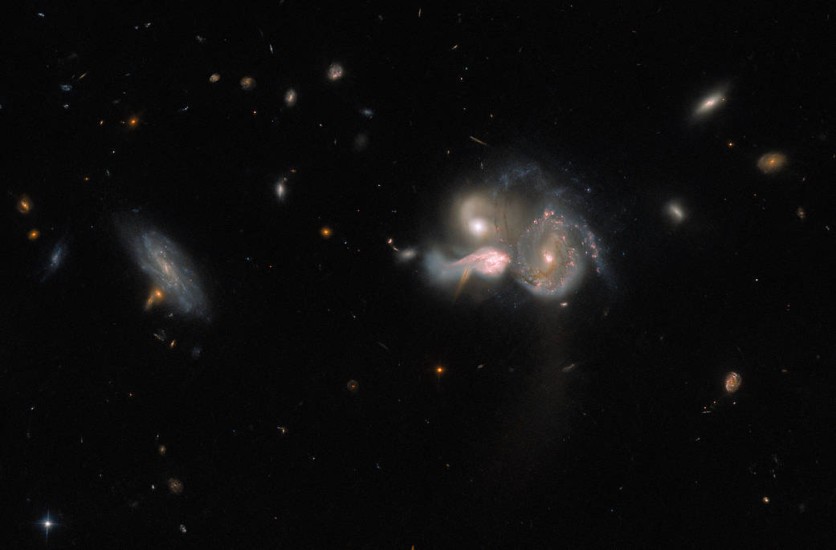NASA's Hubble Space Telescope captured a cute trio of merging galaxies located in the constellation Boötes. These three galaxies are on a collision track and will eventually merge into a single, bigger galaxy, causing gravitational interactions between them to alter one another's spiral structures.
The blurred forms of many more distant galaxies can be seen in the background, and a seemingly unconnected foreground galaxy appears to float serenely close to this scenic galactic sight.
Three galaxies are gathered together to the right of the image's center. They are so close together that it seems like they're merging into one. Their shapes are also distorted by strands of gas and dust that are running between them.

Merging Trio
According to the image's description, these galaxies are ejecting huge amounts of light. A disconnected, fainter spiral galaxy can also be seen further to the left.
The image features a few smaller, dim, and faint galaxies, as well as a few stars against the background of darkness.
This merging trio, also known as SDSSCGB 10189 to astronomers, is a rather uncommon combination of three massive star-forming galaxies that are only 50,000 light-years apart from one another.
Although this may seem like a safe distance, it is important to note that galaxies are very close neighbors when they are at that distance.
Meanwhile, the Milky Way's neighbors are significantly further away. This is true with the Andromeda galaxy which is more than 2.5 million light-years from Earth.
Galaxies' shapes will be drastically altered when they undergo a merging process with galactic neighbors. An elliptical galaxy, for instance, can result from the merging of two spiral galaxies.
NASA explains that "although galaxies have a lot of starts, it is very unlikely that starts from both galaxies actually collide. This is because of all the space in between the stars. As the galaxies merge the start would just pass by each other."
Star formation can potentially be sparked by merging galaxies since they are made of gas and dust as well. This material may be affected by the gravitational pull of both colliding stars, resulting in friction and shock waves that could give birth to new stars.
Bright Cluster Galaxies
The new Hubble image is the result of an observation made to aid astronomers in understanding the formation of the universe's largest and most massive galaxies.
These enormous galaxies are known as Brightest Cluster Galaxies (BCGs), and as their name implies, they are the brightest galaxies in any particular galaxy cluster. Scientists believe that massive, gas-rich galaxies like the ones pictured here merge to produce BCGs.
The team used Hubble's Wide Field Camera 3 and Advanced Camera for Surveys to painstakingly study this galactic triple to offer information on the birth of the universe's most massive galaxies.
Related Article : Star Sonification: NASA Releases Soundtrack of a Glittering Star 200 Times Larger than the Sun

ⓒ 2025 TECHTIMES.com All rights reserved. Do not reproduce without permission.




